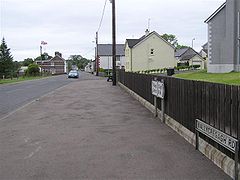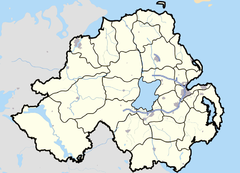- Cloughmills
-
Coordinates: 55°00′04″N 6°17′10″W / 55.001°N 6.286°W
Cloghmills Irish: Muileann na Cloiche[1] 
Ballycregagh Road in Cloghmills
 Cloghmills shown within Northern Ireland
Cloghmills shown within Northern IrelandPopulation 1,240 (2001 Census) District Ballymoney[2] County County Antrim Country Northern Ireland Sovereign state United Kingdom Post town BALLYMENA Postcode district BT44 Dialling code 028 EU Parliament Northern Ireland UK Parliament North Antrim NI Assembly North Antrim List of places: UK • Northern Ireland • Antrim Cloughmills or Cloghmills[3] (pronounced /klɒxˈmɪlz/ klokh-milz) is a village in County Antrim, Northern Ireland. Ballymoney is 15km to the north-west and Ballymena is 16km to the south. It had a population of 1,240 people in the 2001 Census.
Contents
Name
The name Cloughmills/Cloghmills is a combination of the Irish word cloch (meaning "stone") and the English word mill (referring to the linen mill around which the village grew). An older spelling was Clochmills.[4]
Features
Cloghmills is a local service centre for its surrounding rural hinterland with a good range of retail, commercial, community and educational facilities. Recreational facilities are, however, limited, relative to the size of the village. A substantial number of private sector dwellings have been built over the past decade, which reflect its growing residential function.[2] Three private housing developments have been built in the village within the past 10 years, substantially increasing the population to approximately 2000 individuals in 2008.[citation needed] The Cloughmills Community Action Team (CCAT), made up of local residents, is in the process of reviving a five year action plan to develop the village for the all who live there, and promote and develop local business initiatives.[5] Cloughmills is also home to one of Northern Ireland's leading department stores, Logans of Cloughmills.
History
The industrial heritage of the village can be seen from the old linen mill which is located at the bottom end of the main street beside the medical centre. The mill was fed by the Cloughwater (also known as the Cloughmills Water) river which flows through the southern end of the village. This river feeds into the River Maine.
In 1910, corn and flax scutching were the main industries and an Agricultural and Dairy Society and Co-operative Poultry and Egg Society had been established. The population was about 200.[6]
The former main employer of the village, Cooneen Textiles, a clothing firm, closed down in 1999 with the loss of 128 jobs. The premises changed hands and Cooneen was replaced by a haulage company called Reid Transport. In November 2007 Reid Transport ceased trading with loss of 200 jobs following serious financial difficulties. Indications are that a company called "African Clothing Company," may be taking up residence in the vacated premises, however this remains to be confirmed.[citation needed]
The Troubles
- On 12 Ferbruary 1977 off duty Royal Ulster Constabulary (RUC) member was Samuel McKane was killed by the Provisional Irish Republican Army (IRA) outside his home in Cloughmills.[7]
- On 14 March 1978, Provisional Irish Republican Army (IRA) masked gunmen planted two explosive devices at the Cloughmills Cooperative Society and Spar supermarket complex. The gunmen fired two shots in the air and escaped by car. The homemade explosive devices exploded causing minor structural damage and starting a fire which destroyed the interior.[8]
Transport
Cloughmills has good road links to Ballymoney and Ballymena and is located a short distance east of the A26 key transport corridor. However, it has limited public transport connections.[2]
Education
- Cloughmills Primary School
- St Brigid's Primary School
Religion
- Killagan Church of Ireland Parish Church is just outside the village.[5]
- Cloughmills Free Presbyterian Church.
- Cloughmills Reformed Presbyterian Church.
- Ballyweaney Presbyterian Church.
- Church of the Sacred Heart.(Roman Catholic)
Notable people
Notable people from Cloughmills include:
- Stumpy McCloskey – a singer and violin player. McCloskey played in many traditional music festivals throughout Ireland.[5]
- Samuel Robinson – Emigrated to America in 1888 and became a successful multi-million dollar businessman. Robinson settled in Philadelphia and founded the American Stores Company (more commonly known as the acronym ACME). He built the Robinson Memorial Hospital in Ballymoney in 1933 in memory of his late parents.[5]
Demographics
Cloughmills is classified as a Village by the NI Statistics and Research Agency (NISRA) (i.e., with population between 1,000 and 2,250 people). On Census day (29 April 2001) there were 1,240 people living in Cloughmills. Of these[9]:
- 24.1% were aged under 16 years and 16.2% were aged 60 and over
- 49.4% of the population were male and 50.7% were female
- 36.6% were from a Catholic background and 61.9% were from a Protestant background
- 3.6% of people aged 16-74 were unemployed
International relations
Twin towns - Sister cities
 Benbrook, Texas, USA
Benbrook, Texas, USA Vanves, France
Vanves, France
References
- ^ Placenames Database of Ireland
- ^ a b c "Cloughmills Settlement Designation". Planning Service - Draft Northern Area Plan 2016. http://www.planningni.gov.uk/AreaPlans_Policy/Plans/Northern/draft_plan/Volume2/Part4/Villages/Cloghmills.htm. Retrieved 2008-07-15.
- ^ Northern Area Plan 2016 - Ballymoney Borough: Cloghmills, Northern Ireland Department of Environment
- ^ Tour through Ireland: Particularly the interior and least known parts, Volume 2. Printed for R.P. Moore, 1813.
- ^ a b c d "Cloughmills". Culture Northern Ireland. Archived from the original on 2008-06-09. http://web.archive.org/web/20080609024209/http://www.culturenorthernireland.org/YourArea.aspx?location=410. Retrieved 2008-07-15.
- ^ "Cloughmills, County Antrim". Belfast and Ulster Towns Directory for 1910 (Library Ireland). http://www.libraryireland.com/UlsterDirectory1910/Cloughmills.php. Retrieved 2008-07-15.
- ^ CAIN List of deaths 1977
- ^ "Bomb Attack (Cloughmills, County Antrim)". House of Commons Hansard (20 March 1978). http://hansard.millbanksystems.com/written_answers/1978/mar/20/bomb-attack-cloughmills-county-antrim. Retrieved 2008-07-15.
- ^ "Area Profile of Cloughmills - Based on 2001 Census". NI Neighbourhood Information Service. http://www.ninis.nisra.gov.uk/mapxtreme_towns/report.asp?SettlementName=Cloughmills&bandName=Village. Retrieved 2008-07-15.
Categories:- Villages in County Antrim
Wikimedia Foundation. 2010.

